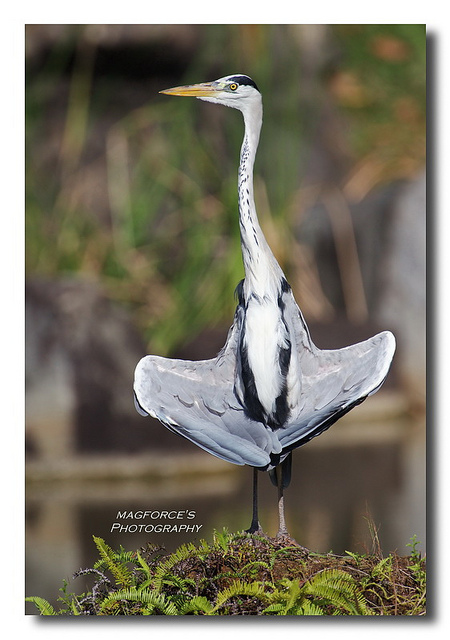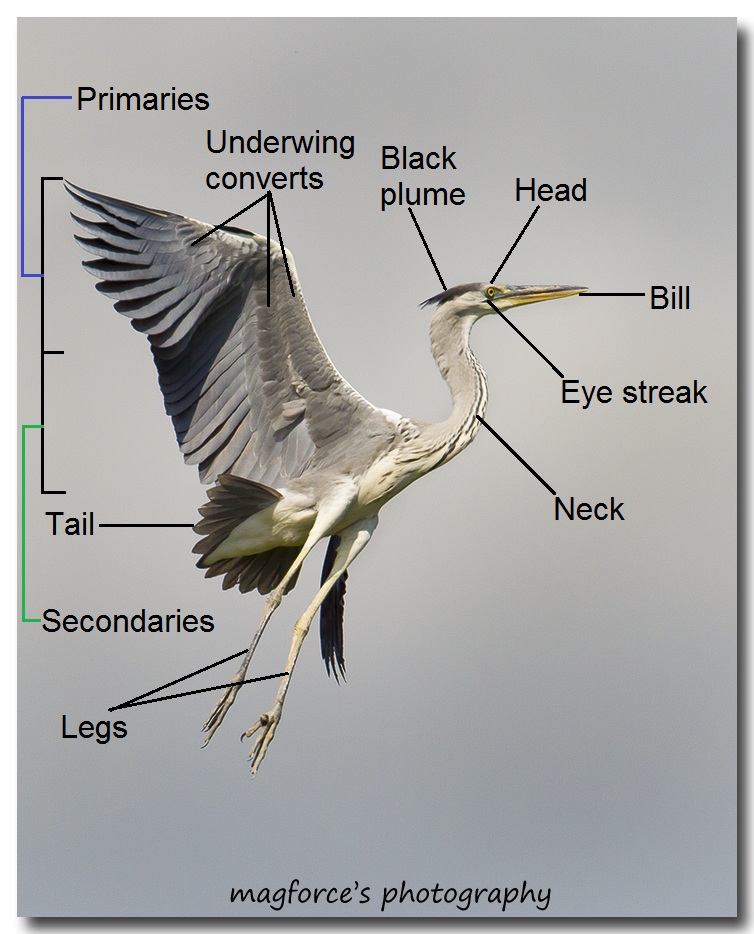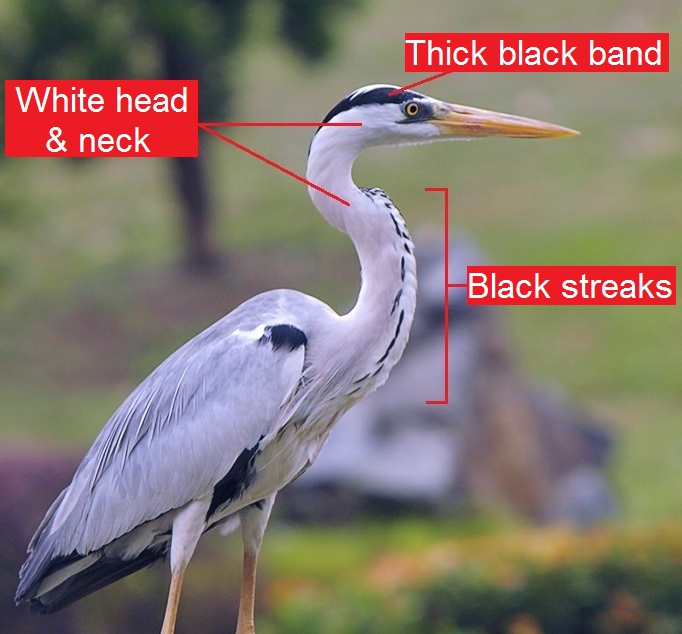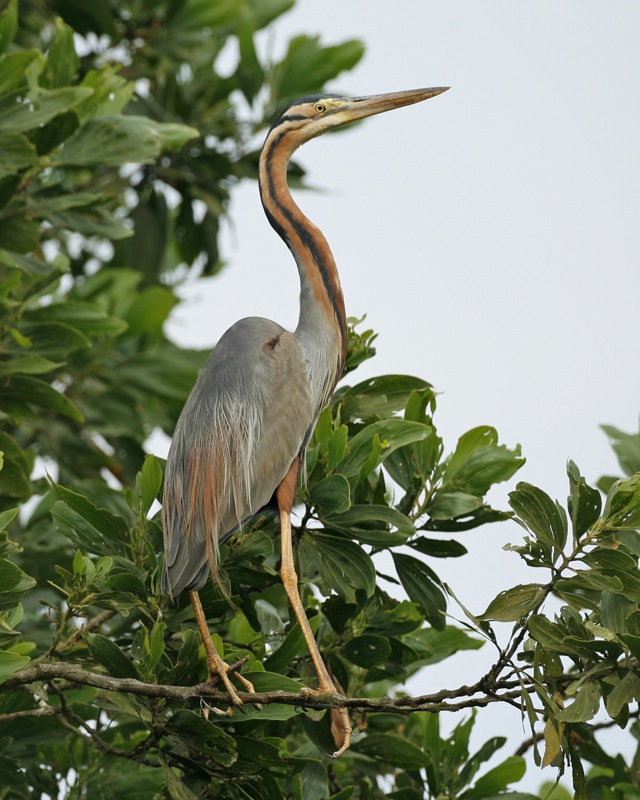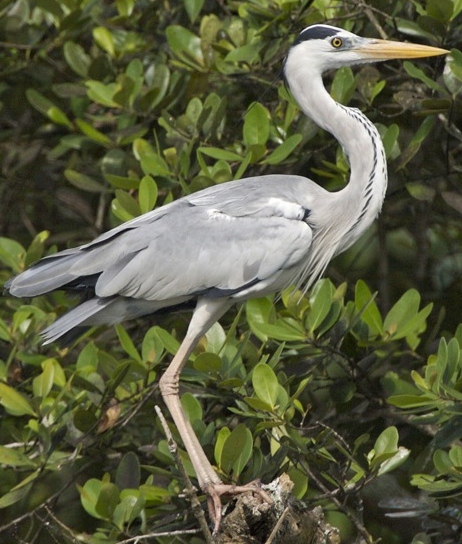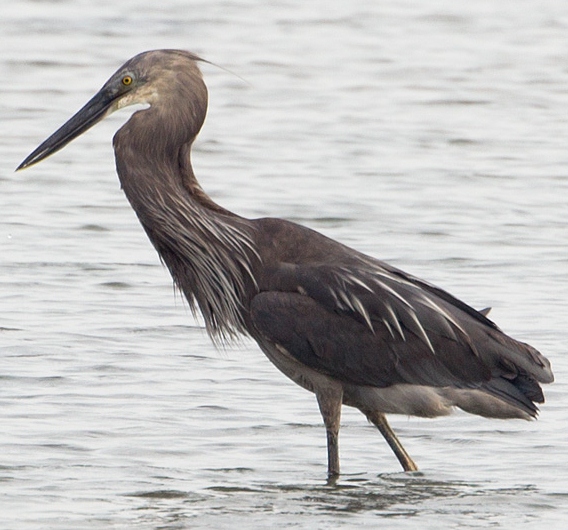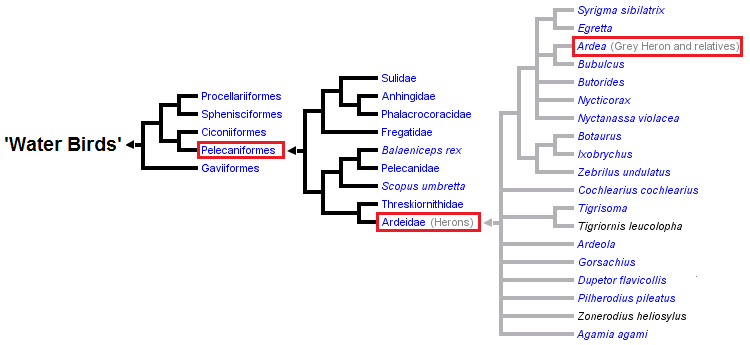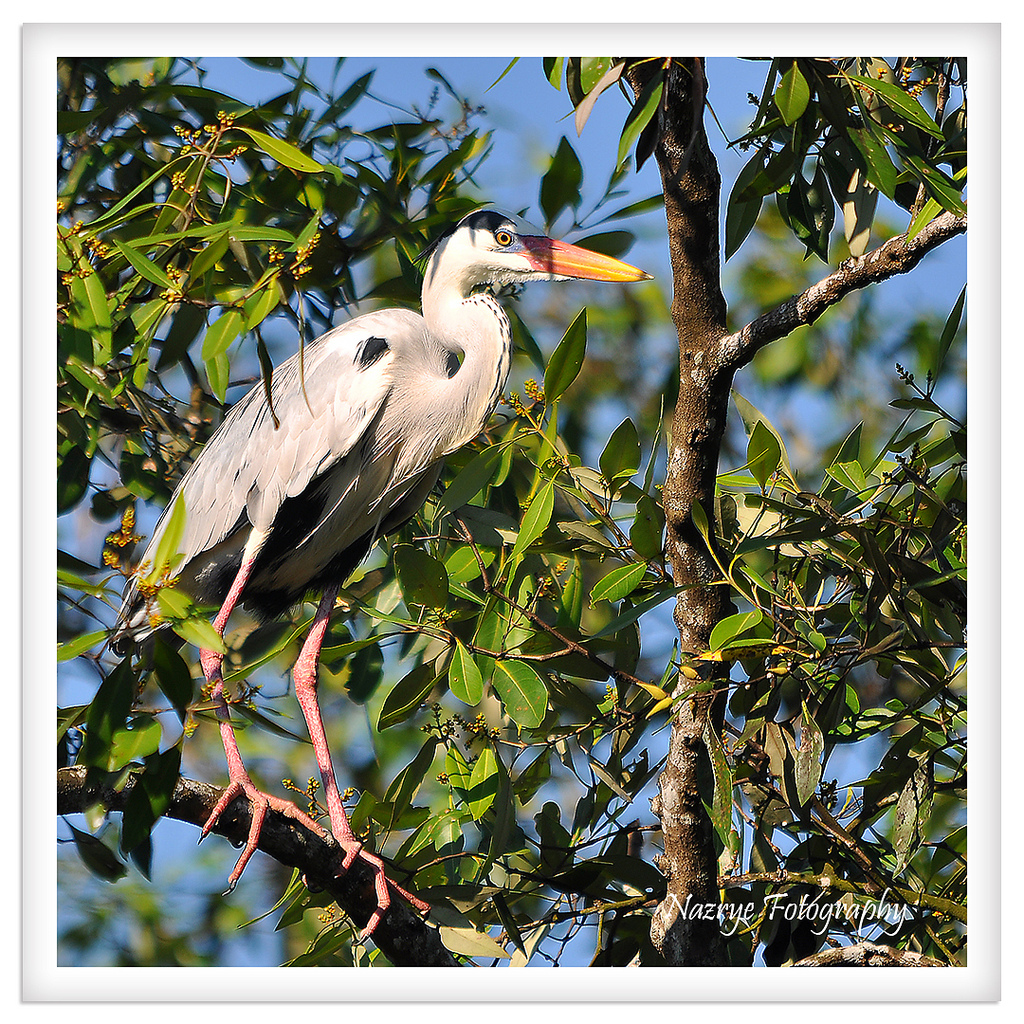Table of Contents
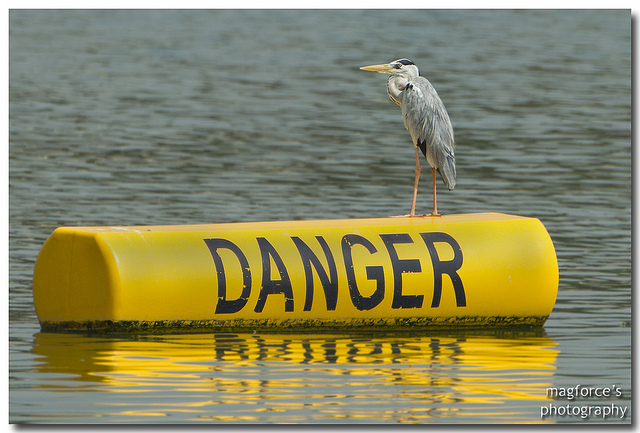 |
| "Dangerous" Grey Heron at bay. (Photo by: Jason) |
Dangerous bird?!
The Grey Heron may be a descendent of the dinosaurs, but usually does not cause harm to humans. Nonetheless, even as young juveniles, Grey Herons display some "aggressive" behaviours towards their parents and siblings.
--------------------------------------------------------Ferocious or harmless? Find out for yourself below.
Name and Etymology
|
- - - - - - Scientific name: Ardea cinerea-Common name: Grey Heron, Gray Heron--In latin, Ardea = Heron; cinerea = grey or ash coloured. (cinis means ashes) (Robinson, 2005). Hence, the bird is given the common name Grey Heron (or Gray Heron).- -The Grey Heron was first described by Linnaeus in the 10th edition of Systema Naturae (1758). The type specimen originated from Sweden, and the original description can be found here. |
Biology
Grey Herons are usually solitary, although they may occur in small loose flocks occasionally (Jeyarajasingam, 2012).
Feeding Habits
Grey Herons are excellent predators, feeding on food such as fishes and frogs (Briffett, 1993). During feeding, Grey Herons fancies hunting alone in order to take full advantage of the available resources in its feeding ground. Standing stationary in shallow water is a strategy that the Grey Herons employ (Briffett, 1986). When a prey is detected, they quickly extend their neck to stab the prey with their bills before retracting back their necks. The prey is then adjusted in the bill until it is able to be swallowed whole.
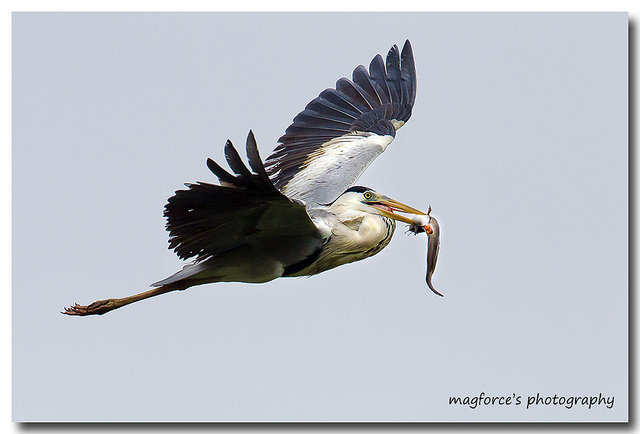 |
| Fancy a food delivery? (Photo credit: Jason) |
Reproduction
In Singapore, Grey Herons probably can breed all year round (Tan, 2001). From laying of eggs to chick hatching, and finally the young leaving the nest, the whole progression takes around three months (Gan, 1997).
Courtship
Despite being solitary most of the time, especially during feeding, Grey Herons adopt a more sociable character during the breeding season, typically forming breeding colonies among tall emergent trees (Tan, 2001). The process of courtship starts with the male Grey Herons, as they begin to collect nesting materials (e.g. twigs) after arriving at a suitable nesting site high up on trees. While defending their respective sites from other males, the male Grey Heron tries to attract the opposite gender (Tan & Vickerman, 2010). Courtship behaviour includes stretching of necks. pointing bills skywards, clapping of bills and displaying erected plumes.
Nest Building
Once the courtship process is successful, the Grey Heron couple proceeds to build their nest. Males will collect and bring the nesting materials, while the females will be responsible for constructing the actual nest (Tan & Vickerman, 2010). The nest is typically a platform made of sticks and branches (Tan, 2001).
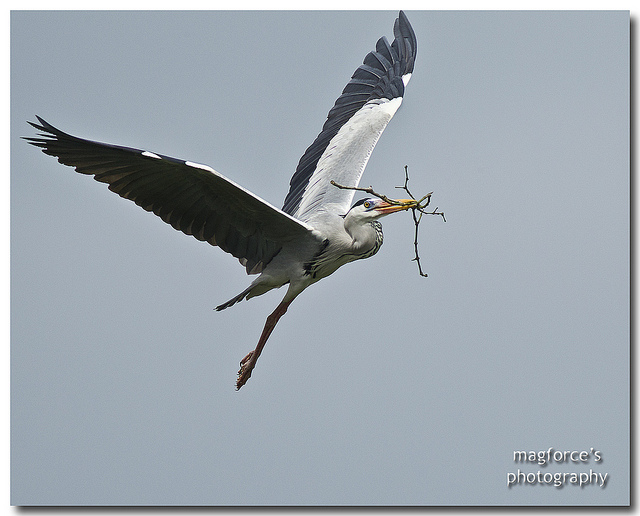 |
| Grey Heron carrying nesting material. (Photo by: Jason) |
Breeding
After completing the nest construction, mating occurs, where the males will attempt to mount on the back of the females, balancing by spreading out their wings (Tan & Vickerman, 2010). Around 3 to 5 pale blue coloured eggs are laid (RMBR, 2012).
Hatching
Before the chicks can hatch after approximately 50 days, incubation of eggs by both parents happens for around 25 to 26 days (RMBR, 2012). During incubation, the parents take turns to forage for food, ensuring that there is always one parent performing the duties of egg incubation and nest guarding at all times (Kwong 2010).
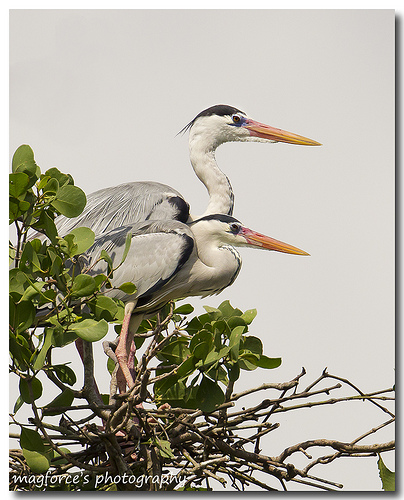 |
| Grey Heron parents at nesting site. (Photo by: Jason) |
Parental Care
After hatching, chicks will remain in the nest for about 10 to 20 days (RMBR, 2012). They are being fed by their parents, which regurgitate their swallowed food (Kwong, 2011), often consisting of fishes.
Older chicks or juveniles will usually produce "begging" calls for food, and peck at their parents’ throats using their bills to stimulate regurgitation (Kwong, 2011). Such behaviour appears to be aggressive, especially among the juveniles who are approaching adulthood since they have a relatively close size and height to their parents. Sharp bills of the young may hurt their parents and siblings in the process. In relation to such behaviour, a study have shown that the competition of food between siblings can result in siblicide of younger chicks, while abundant quantity and quality of food brought back by foraging parents are suggested to reduce siblicide probabilities (Jakubas, 2004).
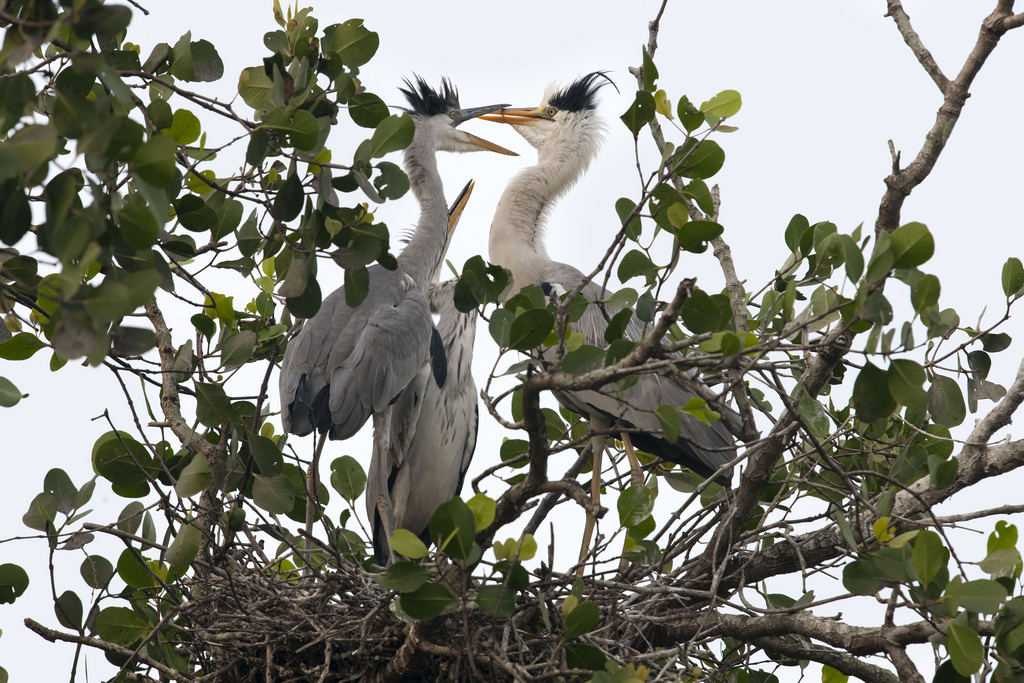 |
| Grey Heron adult with chicks. (Photo by: KS Kong) |
Flight Habits
Interestingly, like other birds in its family, the Grey Heron bends and curves its long neck into a distinct “S” shape during flight, making it look deceptively shorter in height. On the other hand, its legs adopt a stiff straightened posture, positioned below its tail (Briffett, 1986).
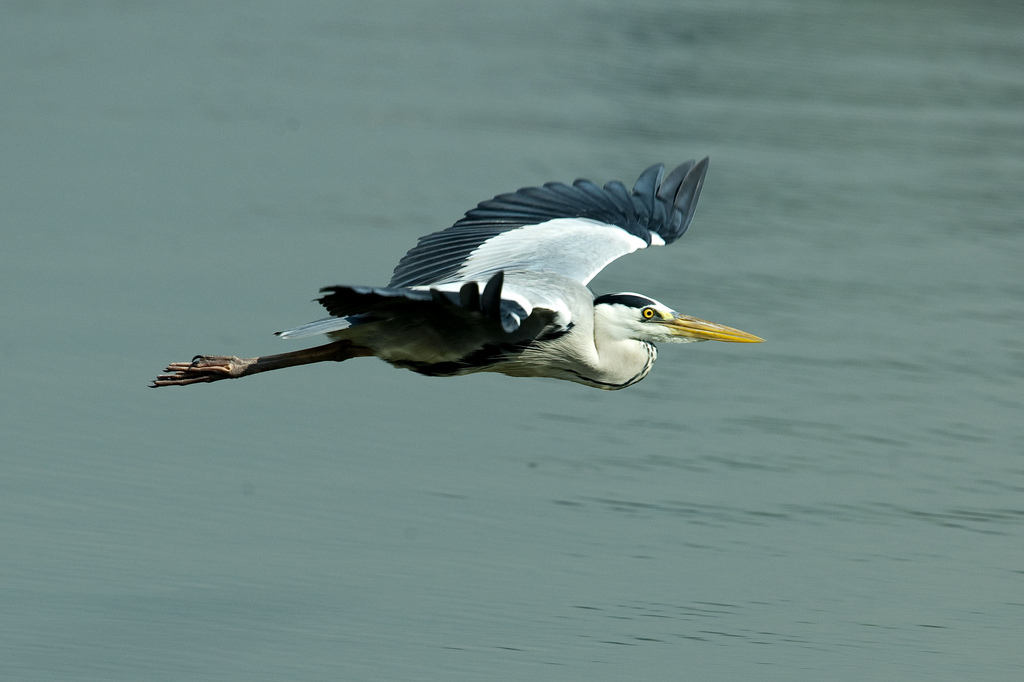 |
| Grey Heron in flight. (Photo by: KS Kong) |
During both take-off and landing, Grey Herons are usually rather clumsy. Nonetheless, they can steadily fly long distances by flapping their wings slowly and deliberately (Briffett, 1986). This is especially important for Grey Herons living in the northern side of the globe, which flies and migrate southwards over a long journey during winter.
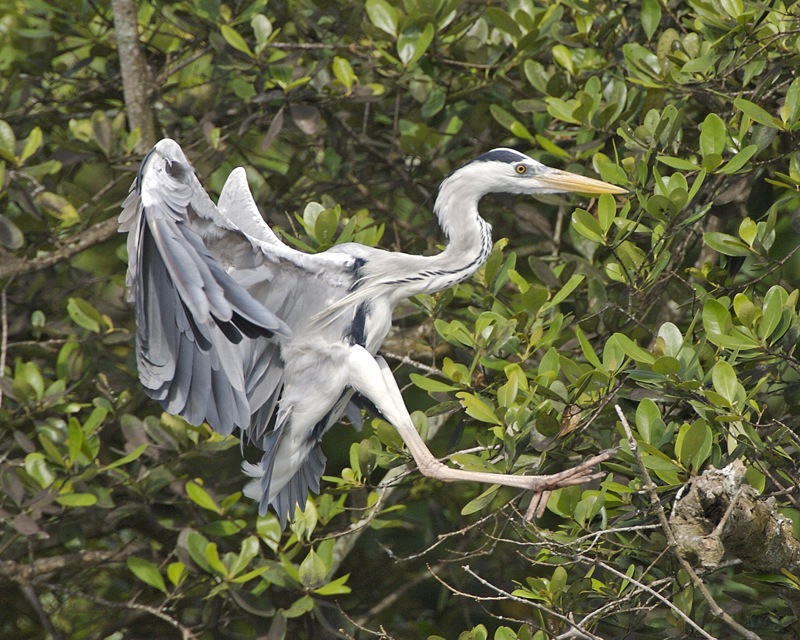 |
| Grey Heron clumsy landing. (Photo by: Dr. L. K. Yap) |
Calls
Generally, the Grey Heron makes its call during flight, and produces a harsh “kraank” sound (Jeyarajasingam, 2012). Nevertheless, they are also able to make different calls in variation with the activity involved, such as during mating. When startled, these birds can make deep guttural calls as well (Davison & Yeap, 2010). A list of varying types of call can be found here.
Description
Adult
There is no difference in the general morphological characteristics between males and females . However, in terms of weight and size, males weigh approximately 1.5 kilograms while females are lighter and smaller (Gan, 1997).Adult
|
--Height:90 to 98 cm-Head:White, with conspicuous eye streak below eye.Black plumes appearing like a thick band runs across the head from top of eye to nape-Bill:Yellowish, long and pointed-Neck:Long and white coloured, many irregular black streaks of unequal length on foreneck-Body:Underside of body mainly white-Legs:Generally brown-Wings:Broad and round. When wings are folded, upperwing appears to be fully grey.In flight, Primaries and Secondaries look black or grey.-Wingspan:Up to 2 metres |
Breeding Adult Changes
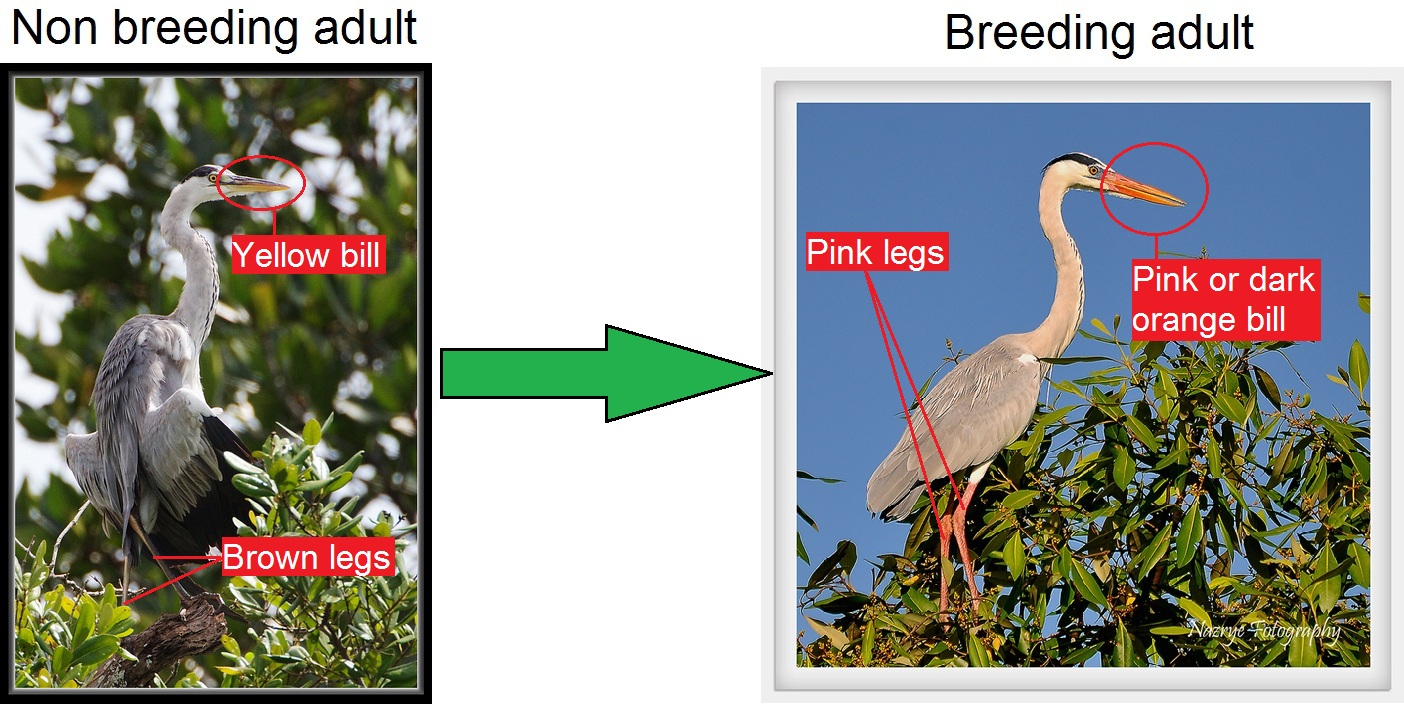 |
| Breeding colours transition in Grey Heron adults. (Left photo by: Jason; Right photo by: Nazrye, Labelled by: Karen Chew) |
In contrast to the yellow bills, the bills of the breeding adult Grey Herons can turn to a brilliant pink or dark orange colouration. Also, the legs of the breeding adults turn from brown to pink colour (Jeyarajasingam, 2012). Similarly, this occurs for both the males and females.
Juvenile
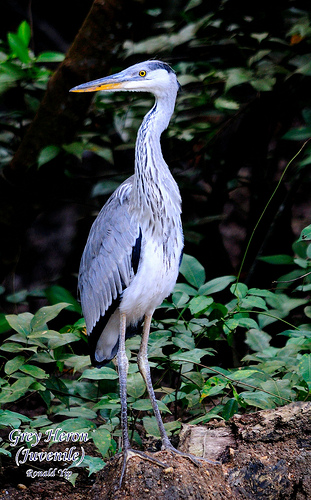 |
| Grey Heron juvenile. (Photo by: Ronald Yip) |
Grey Heron juveniles typically look similar to the adult. However, their colours appear duller, and their necks are more greyish in colour (Jeyarajasingam, 2012).
How to recognise a Grey Heron?
|
- ----The Grey Heron is a relatively large bird that is hard to miss.- -- The diagnostic features include:-1) White head with a distinct thick black line running from its eyes to its nape-2) White long neck-3) Foreneck bearing streaks of black lines-4) Distinct grey coloured wing upperparts |
Other than the Grey Heron, two other species of large herons can be found in Singapore. Due to their similar big sizes and style of flight, they may be confused with each other. Features used to differentiate between the three species of heron are listed below.
| Features |
Herons |
||||||||
Purple Heron
|
Grey Heron
|
Great-billed Heron
|
|||||||
| Size |
Large (80 - 90cm) |
Larger (90 - 98cm) |
Larger (114cm) |
||||||
| Head and Neck Colour |
Rufous |
White |
Dusky Grey |
||||||
| Wing colour |
Above: Ash Grey Below: Chestnut lining |
Above: Grey Below: Black and Grey beneath |
Above and below: Dark Grey |
||||||
Where can we find Grey Herons?
Global Distribution
Globally, Grey Herons have a wide range of distribution. They can be found in Africa, Europe, temperate Asia regions such as Japan and China, as well as in South and Southeast Asia such as Philippines and Singapore (Jeyarajasingam, 2012).
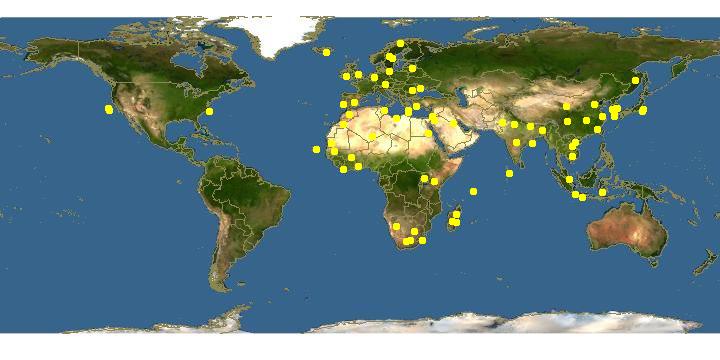 |
| Global distribution of Grey Herons. (Photo retrieved from: © Discover Life and original sources) |
Local Distribution
The Grey Herons dwell in habitats close to water. In Singapore, they can be found at mangroves, mudflats, ponds, canals, reservoir and coasts (Lim & Lim, 2009). Most of the Grey Herons sightings occur along the northern coasts. These include the pockets of mangrove areas that are currently present, such as Sungei Buloh Wetland Reserve and Pasir Ris Mangrove (Lim & Lim, 2009).
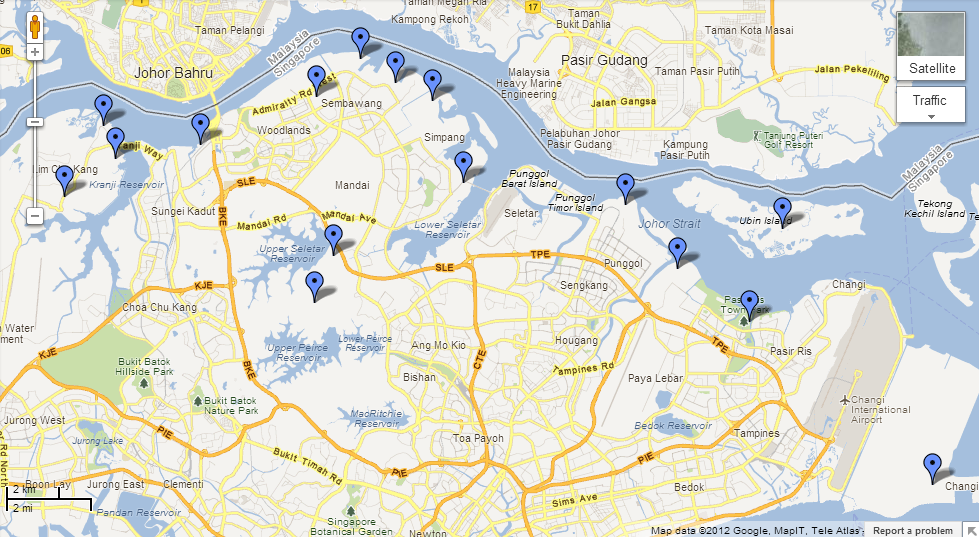 |
| Recorded sites of Grey Heron in Singapore. (Map from Google Maps; Locations mapped according to Lim & Lim, 2009) |
Spotting Grey Herons at Pasir Ris mangrove
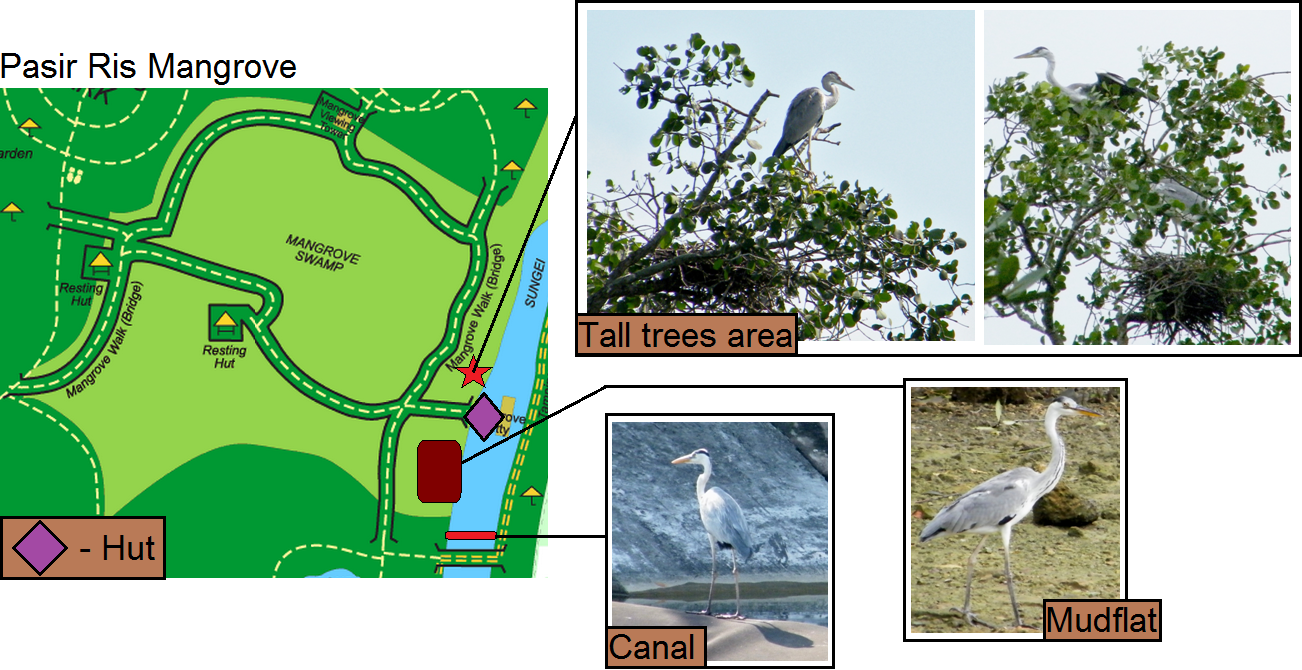 |
| Personal Grey Heron sightings and respective photographs taken at Pasir Ris mangrove. (Left image: Map powered by streetdirectory.com; Right images and labellings by: Karen Chew) |
Other than the Sungei Buloh Wetland Reserve, another site where Grey Herons can be easily spotted is Pasir Ris Mangrove. This is probably due to heronries established on the tall trees along the perimeter of the mangrove and Sungei Tampines river. One of the heronry is situated at the forested area with many tall trees, marked by the "red star" in the map. Due to the location of the heronries, the best spot to view and photograph Grey Herons is probably at the small Hut next to Sungei Tampines, marked by the "purple diamond" in the map above. Other than the heronries, the birds can also be seen to rest and feed at the mudflat (brown rectangle) and canal (red rectangle) areas as shown in the diagram above.
Threats in Singapore
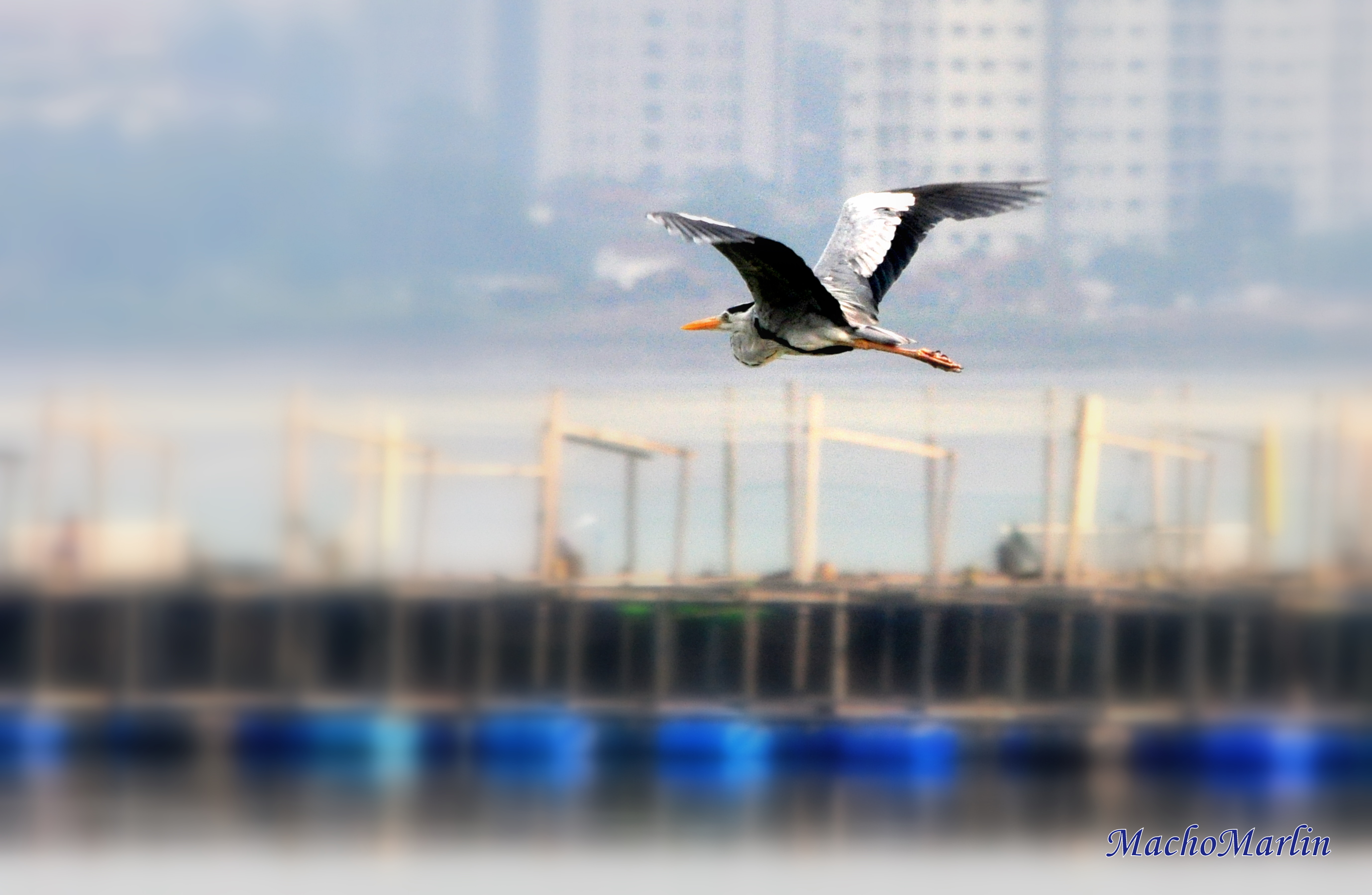 |
| Flying Grey Heron at Sungei Buloh. (Photo from: Ronald Yip) |
The most significant threats that Grey Herons face in Singapore are the loss of habitats and nesting sites. Before the year 1990, there used to be a big breeding colony of approximately 70 pairs of breeding couples at the Kranji River System. However, the habitat and nesting site was lost to the construction of a new transmission station for the Singapore Broadcasting Corporation (now known as Mediacorp) (Lim, 1992). This demonstrates the harmful impact of rapid development on the Grey Herons.
At present, although these large birds have adapted rather well to pockets of remnant areas next to water bodies, they are still vulnerable in the face of constant developmental threats to their habitats or nesting sites.
Conservation Status
Global: Least Concern (IUCN Red List)
Local: Nationally Threatened Species (Nature Society, 2011)
According to the 2011 Checklist of the Birds of Singapore by Nature Society (Singapore) Bird Group, the Grey Heron is listed as a Common bird, and is a Resident Breeder in Singapore.
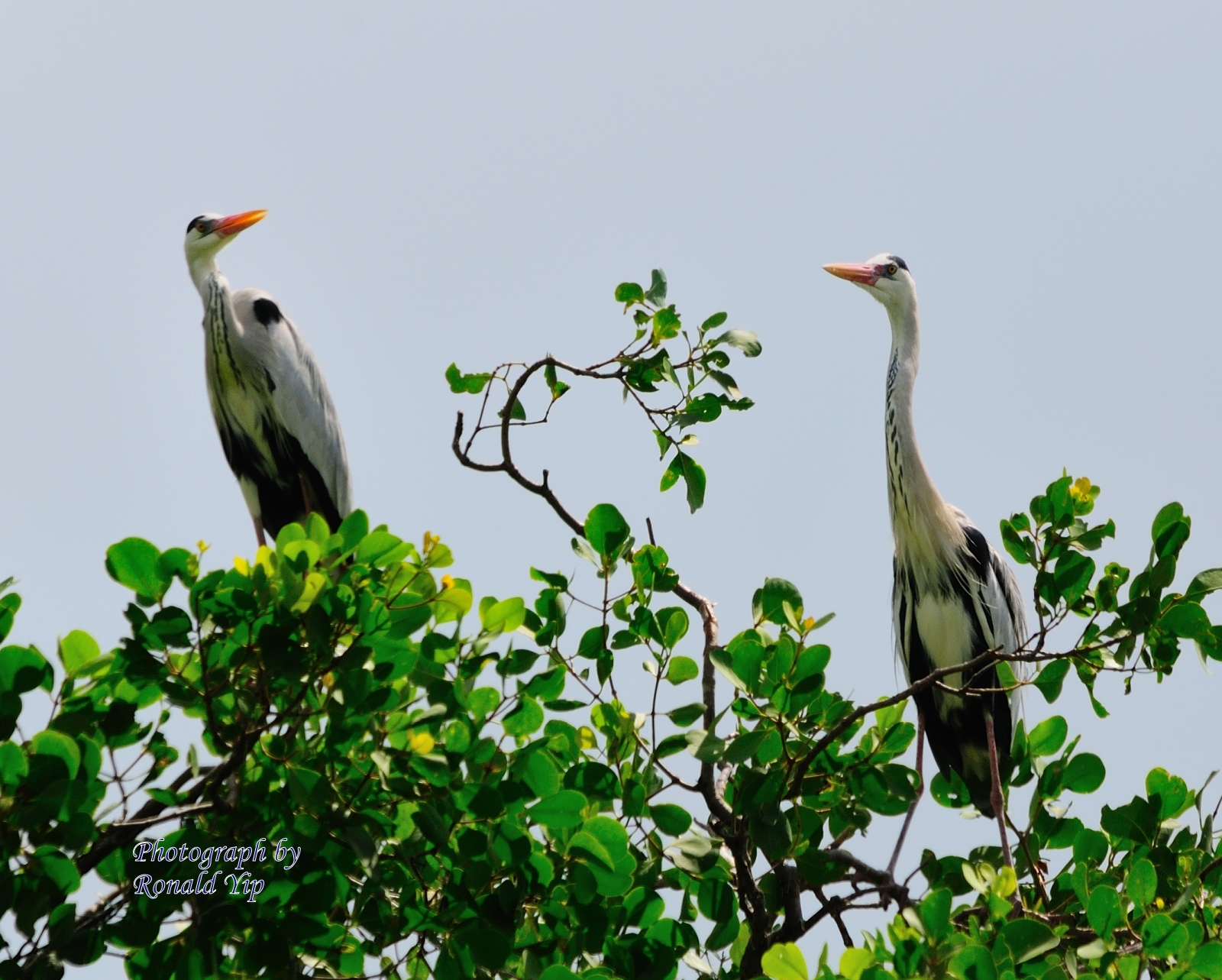 |
| Grey Heron chicks. (Photo by: Ronald Yip) |
Taxonomy
Classification Change
Originally, Grey Herons belonged to the order Ciconiiformes. This was an order in which the families were constantly disputed upon, because the families under this order appears to share similar characteristic with families in orders, such as the Pelecaniformes. Ciconiiformes was thus seen as a taxon resembling a "dumping ground" (Sheldon & Slikas, 1997), and the arguments and issues revolving the organisms in this order were not resolved for a long period of time.
However, in the Year 2008, a paper published by Hackett et al. surfaced as a solution to many phylogenetic relationship problems between many groups of birds. In their study, nuclear DNA sequences from 19 independent loci were obtained from 169 species of birds, and subsequently aligned and analysed. As a result, many genus that were once under Ciconiiformes were regrouped to be under Pelecaniformes (Brown & Harshman, 2008). This includes the genus Ardea, which the Grey Herons belong to.
Importantly, many past books and websites grouped the Grey Herons under the Ciconiiformes order, while updated websites listed them under the order Pelecaniformes. Thus, one should take note of the classification change in order to avoid confusion.
Current Classification
|
- - Kingdom: Animalia ----Phylum: Chordata -------Class: Aves ----------Order: Pelecaniformes -------------Family: Ardeidae ---------------Genus: Ardea ------------------Species: cinerea --------------------Subspecies: ---------------------------------Ardea cinerea cinerea (Linnaeus, 1758) ---------------------------------Ardea cinerea firasa (Hartert, 1917) ---------------------------------Ardea cinerea jouyi (Clark, 1907) ---------------------------------Ardea cinerea monicae (Jouain & Roux, 1963) - - The subspecies of the Grey Heron are very similar, with only slight variation in some morphological characteristics such as shade of colour. Also, each subspecies appears to be found in distinct geographic areas around the world (Bower & Rabago, 2011). - - |
References
- BirdLife International. (2012). Ardea cinerea. IUCN 2012. IUCN Red List of Threatened Species. Version 2012.2. Retrieved from http://www.iucnredlist.org/details/106003715/0
- Bower, J., & Rabago, D. (2011). "Ardea cinerea"(Online), Animal Diversity Web. Retrieved from http://animaldiversity.ummz.umich.edu/site/accounts/information/Ardea_cinerea.html
- Briffett, C. (1986). A guide to the common birds of Singapore. Singapore: Singapore Science Centre
- Briffett, C. (1993). The Birds of Singapore. New York: Oxford University Press
- Brown, J.W., & Harshman, J. (2008). Pelecaniformes. Version 27 June 2008 (under construction). Retrieved from http://tolweb.org/Pelecaniformes/57152
- Davison, G. W. H., & Yeap, C. A. (2010). A naturalist's guide to the Birds of Malaysia and Singapore. Oxford: Beaufoy Books
- Dickinson, E. C., & King, B. F. (1975). A Field Guide to the Birds of South-East Asia. London: Collins
- Discover Life and original sources. (2012). Discover Life: Point Map of Ardea cinerea. Retrieved from http://www.discoverlife.org/mp/20m?kind=Ardea+cinerea
- Gan, J. (1997). The Nesting Herons of Sungei Buloh. Wetlands, 4(1). Retrieved from https://www.sbwr.org.sg/wetlands/text/97-4-1-2.htm
- Glenister, A. G. (1971). The birds of the Malay Peninsula, Singapore and Penang: an account of all the Malayan species, with a note of their occurrence in Sumatra, Borneo and Java and a list of the birds in those islands. Kuala Lumpur: Oxford University Press
- Hackett, S.J., Kimball, R.T., Reddy, S., Bowie, R. C. K., Braun, E. L., Braun, M. J., . . . Yuri, T. 2008. A phylogenetic study of birds reveals their evolutionary history. Science, 320(5884): 1763-1768.
- Integrated Taxonomic Information System (ITIS). (2012). ITIS Standard Report Page: Ardea cinerea. Retrieved from http://www.itis.gov/servlet/SingleRpt/SingleRpt?search_topic=TSN&search_value=174781
- Jakubas, D. 2004. Sibling Aggression and Breeding Sucess in the Grey Heron. Waterbirds: The International Journal of Waterbird Biology, 27(3): 297-303.
- Jeyarajasingam, A. (2012). A Field Guide to the Birds of Peninsular Malaysia and Singapore (2nd ed.). New York: Oxford University Press.
- Kwong, W. C. (2010). Bird Ecology Study Group Nesting Grey Herons: 4. Incubation. Retrieved from http://www.besgroup.org/2010/12/20/nesting-grey-herons-4-incubation/
- Kwong, W. C. (2011). Bird Ecology Study Group Nesting Grey Herons: 7. Feeding ritual. Retrieved from http://www.besgroup.org/2011/02/24/nesting-grey-herons-7-feeding-ritual/#more
- Lim, K. C., & Lim, K. S. (Eds.). (2009). State of Singapore's Wild Birds and Bird Habitats: A Review of the Annual Bird Census 1996 - 2005. Singapore: Nature Society (Singapore)
- Lim, K. S. (1992). Vanishing Birds of Singapore. Singapore: Nature Society (Singapore)
- Nature Society (Singapore) Bird Group Records Commitee. (2011). Checklist of the Birds of Singapore [Data file]. Retrieved from http://www.nss.org.sg/documents/Singapore%20Checklist%202011%20edition.pdf
- Raffles Musuem of Biodiversity Research. (2012). Ardea cinerea. Retreived from http://rmbr.nus.edu.sg/dna/organisms/details/20
- Robinson, R.A. (2005). BirdFacts: profiles of birds occurring in Britain & Ireland (BTO Research Report 407). Retrieved from http://blx1.bto.org/birdfacts/results/bob1220.htm
- Sheldon, F. H., & Slikas, B. 1997. Advances in Ciconiiform Systematics. Colonial Waterbirds, 20(1): 106-114.
- Tan, M., & Vickerman, J. (2010). Bird Ecology Study Group Grey Heron in courtship mode. Retrieved from http://www.besgroup.org/2010/02/27/grey-heron-in-courtship-mode/
- Tan, R. (2001). Grey Heron (Ardea cinerea).Retrieved from http://www.naturia.per.sg/buloh/birds/Ardea_cinerea.htm
Discussion Area
Please feel free to leave any comments below.
